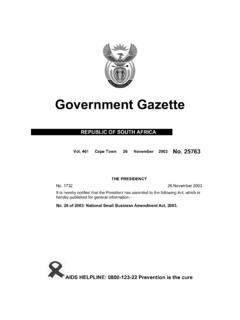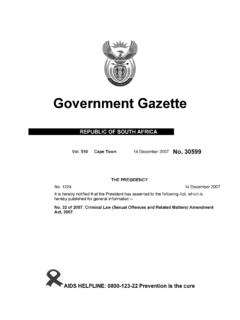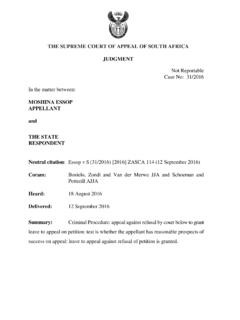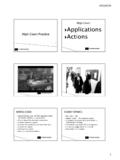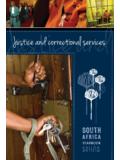Transcription of FREE STATE HIGH COURT, BLOEMFONTEIN REPUBLIC OF …
1 FREE STATE high court , BLOEMFONTEIN . REPUBLIC OF SOUTH AFRICA. Appeal No. : A182/2011. In the appeal between:- RICKY GANDA Appellant and THE STATE Respondent _____. CORAM: VAN ZYL, J et DAFFUE, J. _____. HEARD ON: 6 FEBRUARY 2012. _____. JUDGMENT BY: DAFFUE, J. _____. DELIVERED ON: 5 APRIL 2012. _____. INTRODUCTION. [1] On 4 February 2011 the appellant was convicted by the Regional court at Welkom on two counts of robbery with aggravating circumstances. On the same day he was sentenced to 8 years imprisonment in respect of both counts, such sentences to run concurrently.
2 [2] On 5 April 2011 leave to appeal against conviction was 2. granted by the court a quo. THE ISSUES. [3] It is apparent from the application for leave to appeal that appellant relies on several grounds of appeal, but the two main issues to be considered are (a) whether the acceptance of appellant's identification by the two STATE witnesses is correct and (b) whether appellant's alibi in respect of the two incidents was correctly rejected as not reasonably possibly true. Pertaining to identification it is appellant's case that the ID parade was defective and the court a quo incorrectly accepted the evidence in that regard notwithstanding serious irregularities.
3 One alleged irregularity is the evidence by the STATE witness, Lydia Hlanganiso that the investigating officer was present during the parade and also in the same room with the identifying witnesses. Secondly, the witnesses were able to see the line-up of suspects before the ID parade started. Insofar as appellant's alibi is concerned, it is appellant's case that the court a quo incorrectly doubted the authenticity of the document indicating that he was detained in Mozambique. It is averred that an onus was placed on appellant to prove his innocence insofar as the court a quo 3.
4 Found that appellant should have called the author of the document. It is also alleged that the court a quo, without sufficient reason, regarded the procedure at the border between Mozambique and South Africa as described by appellant questionable. Pertaining to the second incident it is alleged that the court a quo incorrectly found that there was nothing to suggest that the host of a traditional feast/ceremony had to remain on the premises at all time during the ceremony. LEGAL PRINCIPLES. [4] In assessing the evidence, a court must in the ultimate analysis look at the evidence holistically in order to determine whether the guilt of the accused is proved beyond reasonable doubt.
5 This does not mean that the breaking down of the evidence in its component parts is not a useful aid to a proper evaluation and understanding thereof. See S. v SHILAKWE 2012 (1) SACR 16 (SCA) at 20, para [11]. The Supreme court of Appeal approved of the following dictum : But in doing so, (breaking down the evidence in its component 4. parts) one must guard against a tendency to focus too intently upon the separate and individual part of what is, after all, a mosaic of proof. Doubts about one aspect of the evidence led in the trial may arise when that aspect is viewed in isolation.
6 Those doubts may be set at rest when it is evaluated again together with all the other available evidence. That is not to say that a broad and indulgent approach is appropriate when evaluating evidence. Far from it. There is no substitute for a detailed and critical examination of each and every component in a body of evidence. But, once that has been done, it is necessary to step back a pace and consider the mosaic as a whole. If that is not done, one may fail to see the wood from the trees.. See S v HADEBE AND OTHERS 1998 (1) SACR 422 (SCA).
7 At 426F H and S v MBULI 2003 (1) SACR 97 (SCA) at 110, para [57]. [5] The same principles apply when an alibi defence is relied upon by an accused. The acceptance of the evidence on behalf of the STATE cannot by itself be a sufficient basis for rejecting the alibi evidence. Something more is required. The evidence must be considered in its totality. In order to convict there must be no reasonable doubt that the evidence 5. implicating the accused is true which can only be done if there is at the same time no reasonable possibility that the evidence exculpating him is not true.
8 See S v VAN. ASWEGEN 2001 (2) SACR 97 (SCA) at paras [7] & [8], 100f- 101e and S v LIEBENBERG 2005 (2) SACR 355 (SCA) at 358H 359E, paras [14] and [15]. The effect hereof is that once the trial court accepts the evidence in support of an accused's alibi as reasonably possibly true, it follows that the court should find that there is a reasonable possibility that the evidence led on behalf of the STATE is mistaken or false. [6] Bearing in mind the above the correct approach is to consider the alibi in the light of the totality of the evidence in the case and the court 's impression of the witnesses.
9 See R. v HLONGWANE 1959 (3) SA 337 (A) at 341A. In doing so, the trial court should remind itself that no onus rests on an accused and that the STATE must prove that the accused committed the crime and it must therefore disprove the alibi. [7] It is acceptable in evaluating the evidence in its totality to consider the inherent probabilities. Heher AJA (as he then was) dealt with this aspect as follows: 6. The correct approach is to weigh up all the elements which point towards the guilt of the accused against all those which are indicative of his innocence, taking proper account of inherent strengths and weaknesses, probabilities and improbabilities on both sides and, having done so, to decide whether the balance weigh so heavily in favour of the STATE as to exclude any reasonable doubt about the accused's guilt.
10 See S v CHABALALA 2003 (1) SACR 134 (SCA) paragraph [15]. In this regard it is apposite to consider the evaluation of inherent probabilities by the trial court as accepted by the Supreme court of Appeal in MAGADLA v S, 80/2011 [2011]. ZASCA 195 delivered on 16 November 2011, (unreported), at paragraph [22] and further. [8] The right to remain silent and its effect on the disclosure of an alibi defence was thoroughly discussed and considered in the S v THEBUS 2003(6) SA 505 (CC) at 533 and further. The CC, per Moseneke J, found that a distinction may properly be made between an inference of guilt from silence and a credibility finding connected with the election of an accused person to remain silent.







